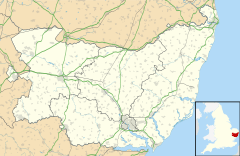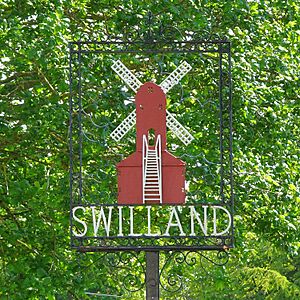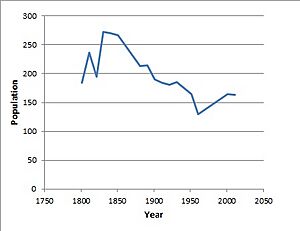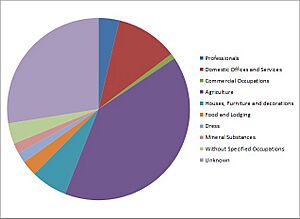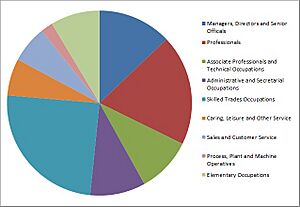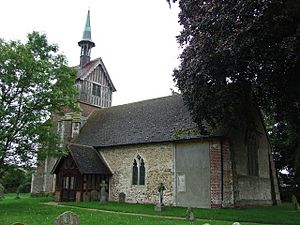Swilland facts for kids
Quick facts for kids Swilland |
|
|---|---|
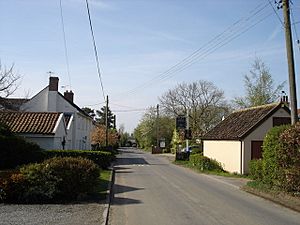 Swilland village |
|
| Population | 163 (2011 Census) |
| OS grid reference | TM1875052953 |
| • London | 87.7 mi (141.1 km) |
| Civil parish |
|
| District |
|
| Shire county | |
| Region | |
| Country | England |
| Sovereign state | United Kingdom |
| Post town | IPSWICH |
| Postcode district | IP6 |
| Police | Suffolk |
| Fire | Suffolk |
| Ambulance | East of England |
| EU Parliament | East of England |
| UK Parliament |
|
Swilland is a small village and parish in the East Suffolk area of Suffolk, England. It's located north of the larger town of Ipswich. Swilland is home to St Mary's Church and a pub called The Moon & Mushroom Inn. This pub has even won "Suffolk Pub of The Year" twice! Swilland works with the nearby village of Witnesham through a shared local government group called the "Swilland and Witnesham Grouped Parish Council."
Contents
History of Swilland
The name Swilland comes from Old English words. It means 'Pig land'. The word 'swīn' meant a pig, and 'land' meant land or an estate.
Swilland in the Domesday Book
Swilland is mentioned in the Domesday Book. This was a big survey of England made in 1086. It shows Swilland was a medium-sized village. It was part of an area called the Hundred of Claydon.
In 1086, Swilland had 13 households. These included 6 villagers, 6 small farmers, and 1 slave. The Domesday Book also recorded animals. In 1066, there were 60 sheep. By 1086, the village had 1 horse, 8 cattle, 19 pigs, and 100 sheep.
Swilland in the 1800s
In the 1870s, Swilland was described as a parish. It was 3.75 miles north-east of Westerfield train station. It was also 6 miles north-east of Ipswich.
At that time, Swilland covered 951 acres. Its total value was £1,869. There were 52 houses, and 243 people lived there. By 1901, the population had dropped to 190 people. The parish covered 956 acres then.
Population Changes in Swilland
The number of people living in Swilland has changed over time. In 1801, there were 184 residents. This number grew to 237 by 1811. Then it went down a bit to 195 in 1821.
In 1831, the population jumped to 272. After that, it slowly went down. It reached its lowest point in 1961 with only 130 people. Since 1961, the population has slowly gone up. In 2011, 163 people lived in Swilland.
Changes in Area
Records show Swilland's boundaries changed. Between 1831 and 1851, the area grew a lot. It went from 520 acres to 951 acres. This big increase in land likely caused the population rise in 1831.
Jobs in Swilland Over Time
In 1881, most people in Swilland worked in farming. About 43 people worked in agriculture. Only 7 people worked with houses or furniture. Just one person had a professional job.
Today, the types of jobs in Swilland are very different. The 2011 census shows 93 people aged 16 to 74 are employed. Only 10 of them work in agriculture now. Many more people work in skilled trades, including farming. There are now 18 people with professional jobs. This is a big change from just one in 1881!
St Mary's Church
St Mary's Church in Swilland was built a very long time ago. It was founded in the 11th century, which means the 1000s! It has a graveyard, and records of burials go back to 1679.
The Church of St Mary, Swilland, is a special building. It is listed as a Grade II* building. This means it is very important historically and architecturally. It was listed on March 16, 1966. The church has a tall tower with a unique lantern spire. This was designed by John Shewell Corder from Ipswich. When you enter the church porch, you can see a Norman doorway. This shows how old parts of the church are.
Swilland Mill
Swilland Mill was first shown on a map in 1825. It was a very tall windmill, standing 51 feet high. It was one of the largest "post mills" in Suffolk. A post mill is a type of windmill where the whole body of the mill turns on a central post.
It is thought that the mill was built for Frederick Buttrum's family. They owned many large mills in other areas like Burgh and Ipswich. Over the years, the mill had different owners. Cyril A. Barron bought it in 1920. The windmill was used until 1936. It was taken down around 1955. Today, the site of the mill is used for holiday homes.
Notable Residents
- Bernard Rooke (1938- ), a famous artist and studio potter.
See also
 In Spanish: Swilland para niños
In Spanish: Swilland para niños


